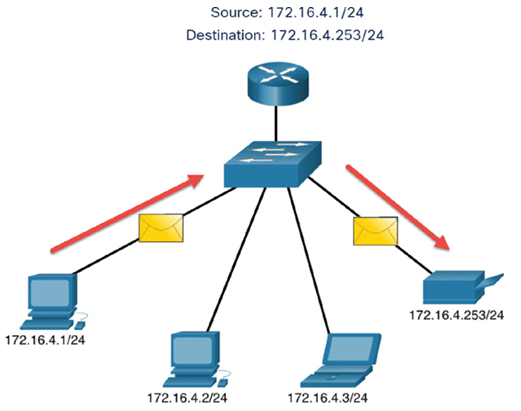Upon completion of this chapter, you will be able to answer the following questions:
• What are the characteristics and uses of the unicast, broadcast and multicast IPv4 addresses?
• What are public, private, and reserved IPv4 addresses?
• Can you explain how subnetting segments a network to enable better communication?
This chapter uses the following key terms. You can find the definitions in the Glossary.
Internet Assigned Numbers Authority (IANA)
Network Address Translation (NAT)
Regional Internet Registry (RIR)
Kishori has a new patient, Divya, who was admitted today. Like Srinivas, Divya does not speak the same language that Kishori speaks. Divya only speaks Telugu and has limited English. Kishori wants to send an email to the nurses on the next shift to determine whether any of them speak Telugu. Kishori can send a multicast email message, which is a single email message sent to specific multiple recipients. You know about the structure of IPv4 addresses. Now it is time to learn more about them. Have you heard of unicast, broadcast, and multicast IPv4 addresses? What are public, private, and reserved IPv4 addresses? Dive into this module to get a deeper understanding of IPv4 addresses!
IPv4 Unicast, Broadcast, and Multicast (9.1)
There are three types of destination IPv4 addresses: unicast, broadcast and multicast. The type of address determines if the packet is intended for a single device or multiple devices.
In the previous topic you learned about the structure of an IPv4 address; each has a network portion and a host portion. There are different ways to send a packet from a source device, and these different transmissions affect the destination IPv4 addresses.
Unicast transmission refers to one device sending a message to one other device in one-to-one communications, as shown in Figure 9-1.
A unicast packet has a destination IP address that is a unicast address which goes to a single recipient. A source IP address can only be a unicast address, because the packet can only originate from a single source. This is regardless of whether the destination IP address is a unicast, broadcast, or multicast.
Note
In this course, all communication between devices is unicast unless otherwise noted.
IPv4 unicast host addresses are in the address range of 1.1.1.1 to 223.255.255.255. However, within this range are many addresses that are reserved for special purposes. These special purpose addresses will be discussed later in this module.

Figure 9-1 Unicast Transmission
Note
In the animation, notice that the subnet mask for 255.255.255.0 is represented using slash notion or /24. This indicates that the subnet mask is 24 bits long. The subnet mask 255.255.255.0 in binary is 11111111.11111111.11111111.00000000.
